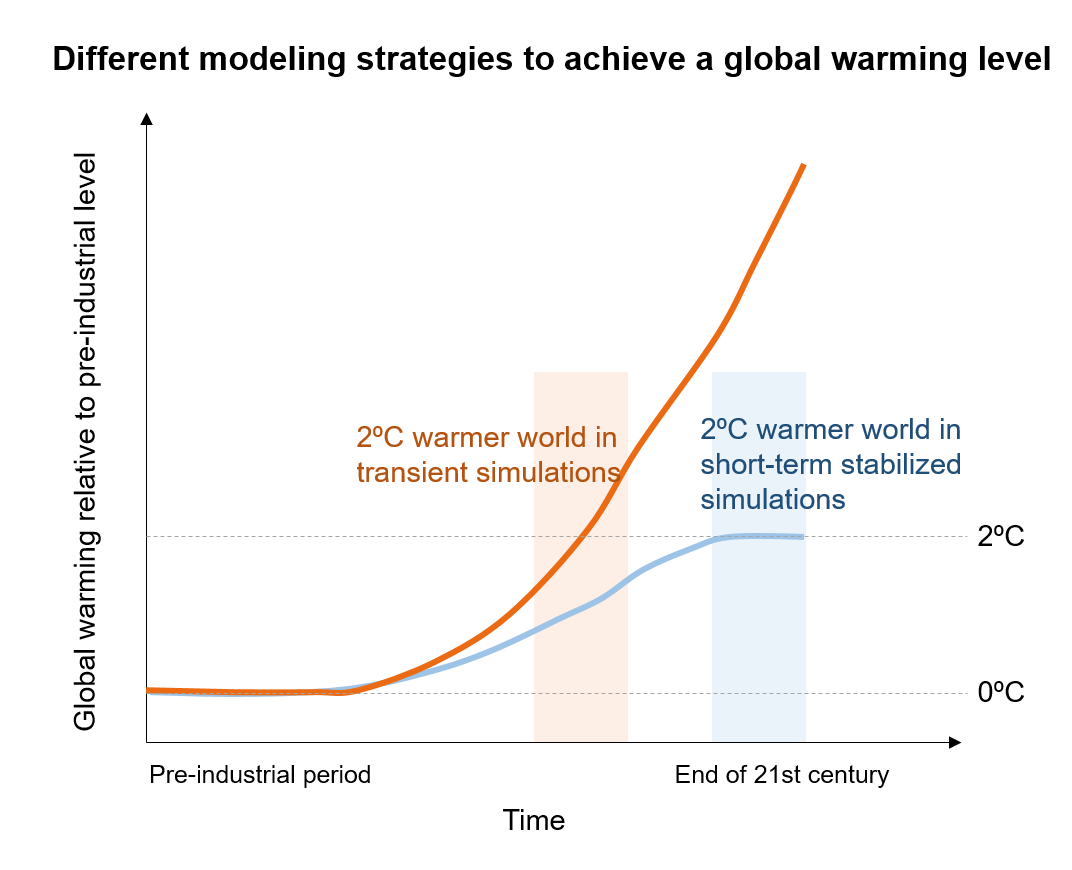中国科学院大气物理研究所大气科学和地球流体力学数值模拟国家重点实验室
State Key Laboratory of Numerical Modeling for Atmospheric Sciences and
Geophysical Fluid Dynamics (LASG)
Institute of Atmospheric Physics, Chinese Academy of Sciences
State Key Laboratory of Numerical Modeling for Atmospheric Sciences and
Geophysical Fluid Dynamics (LASG)
Institute of Atmospheric Physics, Chinese Academy of Sciences

Vol.15/No.15 April 2021
How a Global Warming Target is Achieved Matters
Even with a given global warming level of 1.5°C and 2°C, the associated climate change and the differential warming impacts of the 0.5°C are strongly dependent on how the warming target is achieved, according to a study recently published in Earth's Future. The research reveals different extreme climate projections arising from modeling strategies that are used to achieve the 1.5°C and 2°C warming targets.
To assess the warming impacts, scientists use climate models to achieve these warming scenarios based on various modeling strategies. They include transient atmosphere-ocean coupled simulations, short-term stabilized coupled simulations, and atmosphere-only simulations given a prescribed warming boundary.

Schematic diagram of different modeling strategies to achieve a global warming level (e.g., 2oC warming). The red curve indicates transient warming simulations and the blue curve indicates short-term stabilized simulations.
"While modeling evidence consistently point to reduced impacts from climate extremes on a global scale, if global warming is limited to 1.5°C instead of 2°C, decision-making would require adequate information on uncertainty ranges in projections, particularly the worst-case outcomes," said ZHOU Tianjun, the corresponding author on the paper. ZHOU is a senior scientist at the Institute of Atmospheric Physics (IAP) and CAS Center for Excellence in Tibetan Plateau Earth Sciences in the Chinese Academy of Sciences. He is also a professor at the University of Chinese Academy of Sciences.
"In terms of regional extreme climate change, there are different 1.5/2°C warming states, depending on model setups," ZHANG Wenxia, the first author of the study and a research scientist of IAP, added. "For hot and cold extremes, the model-setup dependency is large in northern high latitudes. For wet and dry extremes, large methodological uncertainty is expected scattered over the globe."
According to the study, the diverse regional changes are directly related to how the 1.5/2°C warmer world is achieved in simulations, dominated by transient versus quasi-equilibrium responses, different external forcings , in particular, aerosols, and prescribed boundary conditions.
These results provide a better understanding of the methodological dependency in assessing climate impacts associated with global warming targets. "Aware of the methodological uncertainty, we need to interpret carefully the projected climate impacts in light of framing of model setups," ZHOU suggested. "The projection uncertainty, particularly the worst-case outcomes, needs to be taken into account in adaptation planning, for example, in designing of infrastructures and water management which are closely related to wet and dry extremes."
The study was jointly supported by the National Key Research and Development Program of China, Chinese Academy of Sciences, National Natural Science Foundation of China and China Postdoctoral Science Foundation.
Citation: Zhang, W., Zhou, T. 2021. The effect of modeling strategies on assessments of differential warming impacts of 0.5°C. Earth's Future. https://doi.org/10.1029/2020EF001640.
Link:https://agupubs.onlinelibrary.wiley.com/doi/10.1029/2020EF001640
Contact: ZHOU Tianjun, zhoutj@lasg.iap.ac.cn
Add: No.40, Huayanli, Beichen West Road, Chaoyang District, Beijing P.O. Box 9804, 100029, China
E-mail: lasg_newsletter@lasg.iap.ac.cn
Editors: Chuanyi Wang (wangcy@lasg.iap.ac.cn), Kangjun Chen(ckj@lasg.iap.ac.cn)
E-mail: lasg_newsletter@lasg.iap.ac.cn
Editors: Chuanyi Wang (wangcy@lasg.iap.ac.cn), Kangjun Chen(ckj@lasg.iap.ac.cn)